Mad Hedge Technology Letter
April 10, 2023
Fiat Lux
Featured Trade:
(UNIGNORABLE SIGNALS)
(AAPL), (HPQ), (NASDAQ)
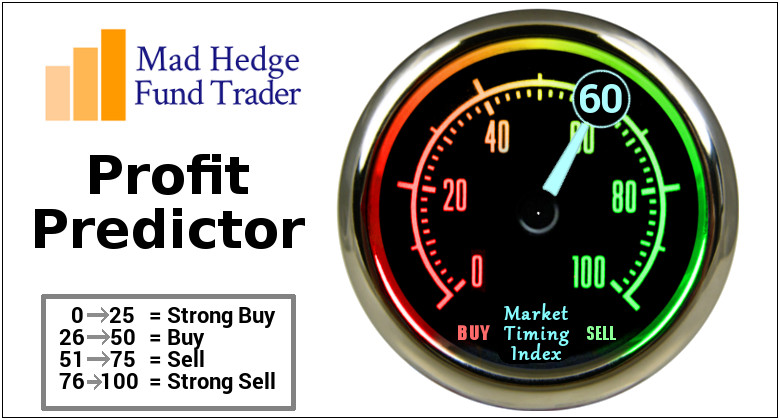
Mad Hedge Technology Letter
April 10, 2023
Fiat Lux
Featured Trade:
(UNIGNORABLE SIGNALS)
(AAPL), (HPQ), (NASDAQ)

This could be the canary in the coal mine for tech that faces a precarious rest of the year.
Personal computers are facing a drop in sales in 2023, and after banging the drum for the last year about an upcoming recession, it might actually be on the way, finally.
When exactly is hard to predict, but it is looking more likely around the third to fourth quarter, unless there are some black and gray swans that explode from nowhere.
Much of the weakness has been pre-empted by mass firings in tech and so the signs have been there.
The hollowing out of Silicon Valley has been due for quite some time now, so just don’t expect your freshly graduated children to ever get a full-time gig at a big name tech company anymore.
That will be reserved for just a few, just like getting a top management job at an NFL football team. These jobs are prized by all, but only begotten by a few.
The new iteration of tech companies will be comprised of an army full of algorithms and human sub-contractors. You might as well extrapolate that theme to the wider economy as well. This is basically the Japanification of the economy.
Apple’s personal computer shipment volume declined by 40.5% in the first quarter which I believe to many is quite surprising, considering the popularity and quality of the product.
Shipments by all PC makers combined slumped 29% to 56.9 million units — and fell below the levels of early 2019 — as the demand surge driven by the work-from-home movement has dissipated.
Among the market leaders, Lenovo Group and Dell Technologies registered drops of more than 30%, while HP was down 24.2%. No major brand was spared from the slowdown, with Asustek Computer Inc. rounding out the top 5 with a 30.3% fall.
Samsung Electronics Co., which provides memory for portable devices as well as desktop and laptop PCs, last week said it’s cutting memory production after reporting its slimmest profit since the 2009 financial crisis.
Apple is gearing up to launch its next slate of laptops and desktops later this year, including a new iMac.
It's also gradually diversifying the geography of its manufacturing base deciding to bet bigger on India and Vietnam.
Looking toward 2024, I foresee a potential rebound for PC makers, driven by a combination of aging hardware that will need to be replaced, and an improving global economy.
Tech shares bounced hard in March as expectations of interest rate hikes were triggered by a slew of bank failures in Europe and America.
That temporary bump in shares delivered a nice 8% return in March and the Mad Hedge Tech Portfolio performed well.
I can say that I am surprised that the Nasdaq only returned 8%, as it should have been more like 12-15% based on the massive re-pricing of rates to now 3 quarter point cuts by the end of 2023.
The market is now betting big that the Fed will pivot and I believe they won’t agree to such fast cuts, which is why, with an April short-term view, I expect bearish price action in tech stocks.

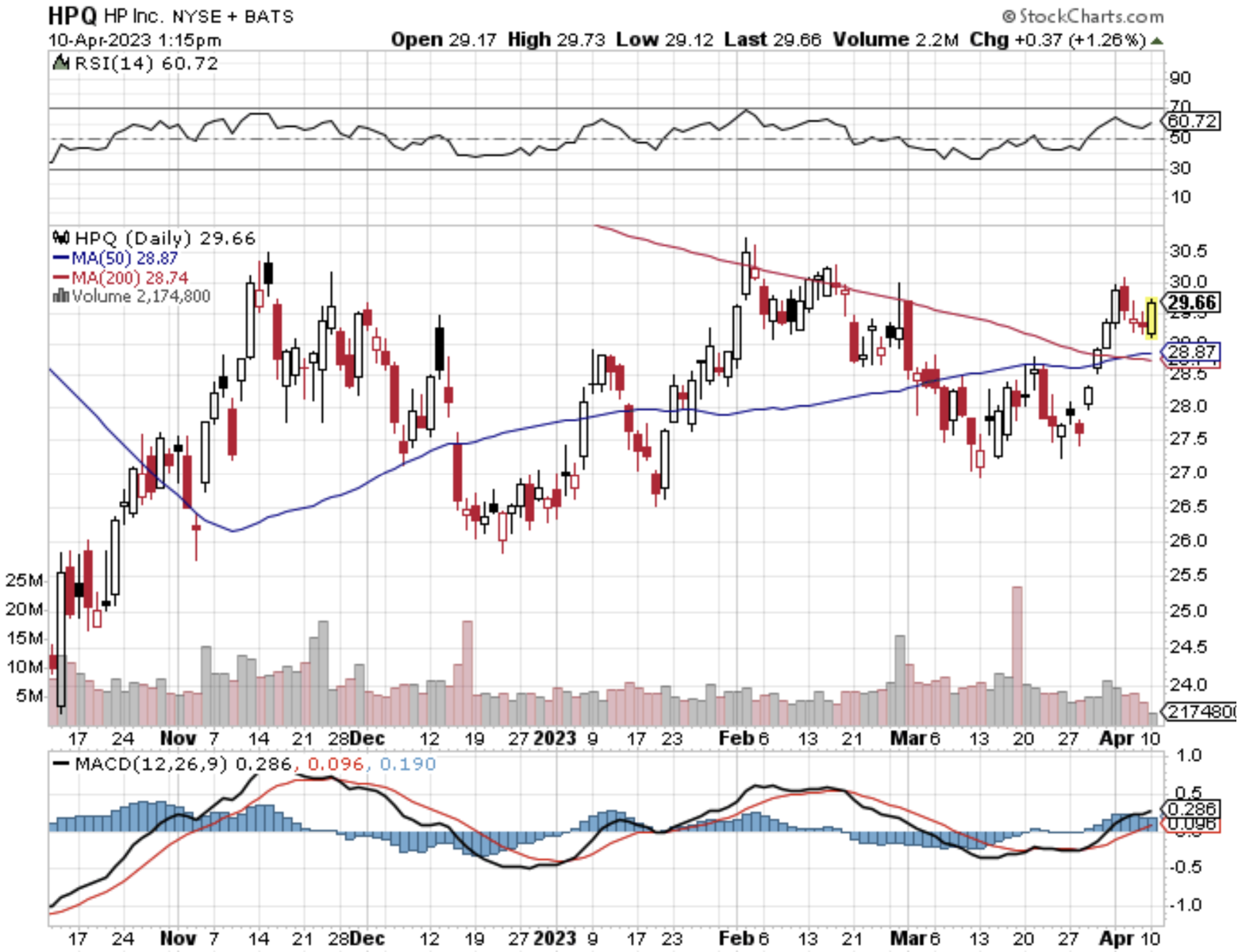
Mad Hedge Technology Letter
March 5, 2019
Fiat Lux
Featured Trade:
(MEET THE PREMIER DINOSAUR OF OUR TIME),
(HPQ), (LNVGY), (DVMT), (AAPL)
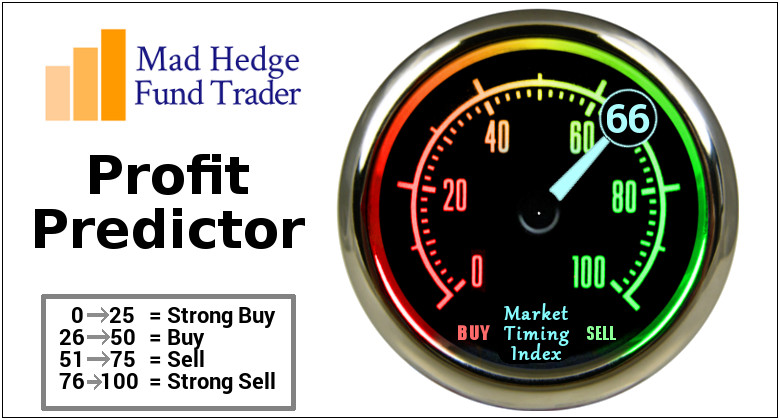
Stay away from HP Inc. (HPQ).
If you want the definition of a legacy tech company, then we have found one of the premier dinosaurs of our time.
The first iteration of Hewlett Packard was in the 1960s when they partnered with Sony to manufacture digital equipment.
They are widely considered the founders of the Silicon Valley establishment that snowballed into what it is today.
In 1939, the Silicon Valley company was established in a one-car garage in Palo Alto by Bill Hewlett and David Packard and initially produced a line of electronic test equipment for Walt Disney.
The garage is classified as a California State historical landmark.
It then developed its products enough to hail itself as the world's leading PC manufacturer from 2007 to 2013, a 6-year reign at the top.
Its long history doesn’t mean the trajectory has been heightened, the company has presided over some major messes such as its purchase of the ill-fated PDA firm Palm and the once discount PC manufacturer Compaq.
HP has had a great seat being able to observe the massive shifts in the tech scene, but unfortunately, its own business model and revenue stream have not been one of the main recipients of this major shift.
According to market research firm IDC (International Data Corporation), China’s Lenovo (LNVGY) recently eclipsed HP (HPQ) becoming top dog in the global PC (personal computers) market.
Lenovo supplanted HP bagging market share of 24.6% on the back of a joint venture with Fujitsu in May 2018 that fueled major incremental gains.
HP still commanded 23.6% share in Q4 2018 among laggards of the likes of Dell (DVMT), Apple (AAPL), and Acer Group with shares of 16.5%, 7.2%, and 6.7%, respectively.
The downtrodden numbers signify that demand for HP personal computers is waning and this is just the tip of the iceberg.
The personal computer industry has been growing in the single digits the last few years and is no more the uber growth industry it once was at the outset of the century.
Last quarter only saw HP’s personal systems segment revenue increase 2.3% YOY.
Total unit sales dropped 3% YOY.
HP blamed the 1% slide on notebook shipments and an 8% decline in desktop shipments.
Evidence tells us that consumers are increasingly valuing mobility more than ever and giving ground to smartphones is inevitable.
Making matters worse, smartphone companies such as Apple, Microsoft, and Google produce outstanding desktop computers that seamlessly integrate into a rich ecosystem.
Consumers are repeatedly buying computers and phones of the same brand that can easily mesh cohesively, a nod to continuity that consumers love.
Professional work stations have also taken the form of an onslaught of one brand of manufacturer whether it be Android-based Microsoft products of iOS-based Apple.
I can vouch for rarely finding someone with a package of Apple’s iPhone and an HP desktop as a professional work hybrid solution unless they are forced by external circumstances.
Essentially, HP is on the wrong side of the pivot to mobile and the lack of innovation is hurting them in a multi-faceted way.
These companies that fail to evolve have a tendency to act as if market conditions never change, only for one bad earnings report to morph into a string of misses tanking the share price.
I believe HP is on that train to nowhere and its lack of investment into creating more advantageous business opportunities sticks out like a sore thumb right now when you compare them to other tech heavyweights.
CEO of HP Dion Weisler had the quote of the century telling analysts on the call that “we’re now engaging on a new battlefield and it’s called online.”
This quote is a microcosm of the state of HP and reflects poorly on the leadership.
One of HP’s largest cash cows is the printing supplies business and for management to blame “online” forces on crimping sales is an insult to shareholders.
“Online” consumer business has been around for more than 30 years, and to reference this external force as a new engagement dragging down sales condemns this company to pariah-status.
Management must wake up and smell the coffee and understand that if selling overpriced print ink and printers was a god given right then HP is doomed strategically.
An unexpected 3% revenue drop in the printer supplies business was written in the stars, and HP has been lucky to even reap what they have to this point.
It’s an ongoing renaissance for consumer prices in a deflationary environment and finding cheaper alternatives is just an Amazon.com visit away.
Selling ink and toner cartridges is a high-margin business that has no business being a high-margin business.
The EMEA region (Europe, Middle East and Africa) printing supplies revenue cratered 9% as most of the world rather buy cheaper alternatives online where they can price compare easily.
Manufacturing cartridges with ink inside it is not high-tech and is due for a margin reckoning.
Apparently, HP has technology that can detect counterfeit ink, but isn’t ink just ink?
HP classifies ink not branded HP as counterfeit ink, once again, a vividly low barrier to entry screaming overpriced.
Such a low-tech competitive advantage should be pounced on - we are seeing that in real time and rightly so.
If business and consumers aren’t allowed to use outside ink to place inside of non-HP cartridges, the business will migrate to non-HP, cheaper replacements such as Canon while either filling up ink cartridges themselves or substituting a cheaper alternative.
The dialogue on the conference call was shocking, appearing if HP executives were caught off-guard from this magical thing called the “internet” and the competition derived from it could potentially suppress sales.
I was leaning towards becoming bearish HP before this earnings report and the awful performance vindicated my initial prognosis.
I am bearish HP – sell on any and every rally.
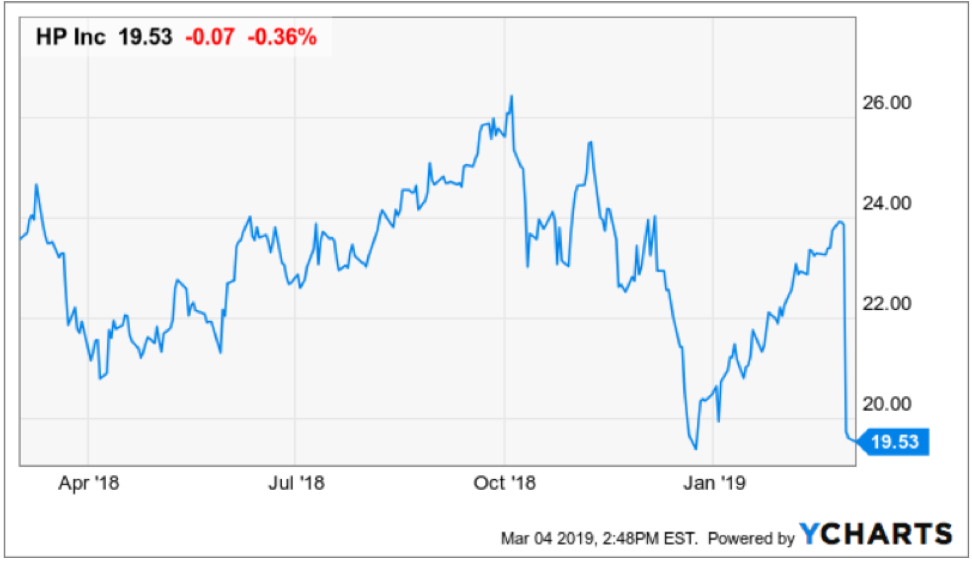
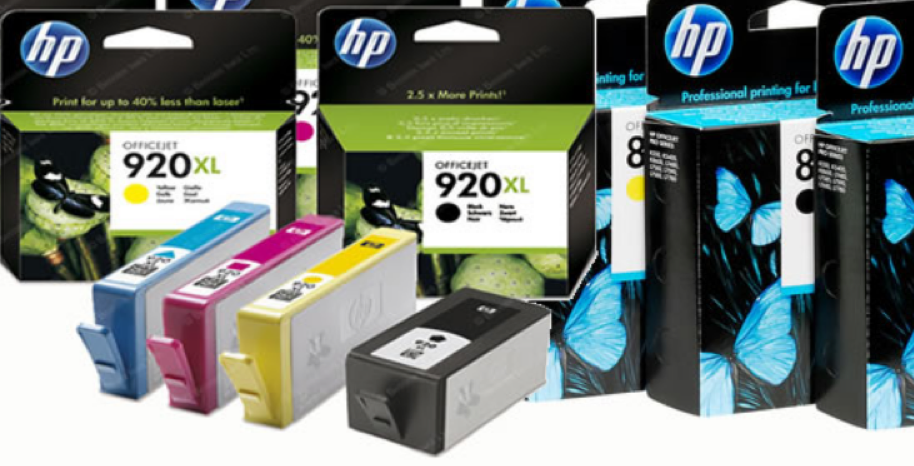
Mad Hedge Technology Letter
September 24, 2018
Fiat Lux
Featured Trade:
(BAD NEWS FROM MICRON TECHNOLOGY (MU),
(MU), (BABA), (KLAC), (LRCX), (INTC), (AMD), (NVDA), (HPQ)
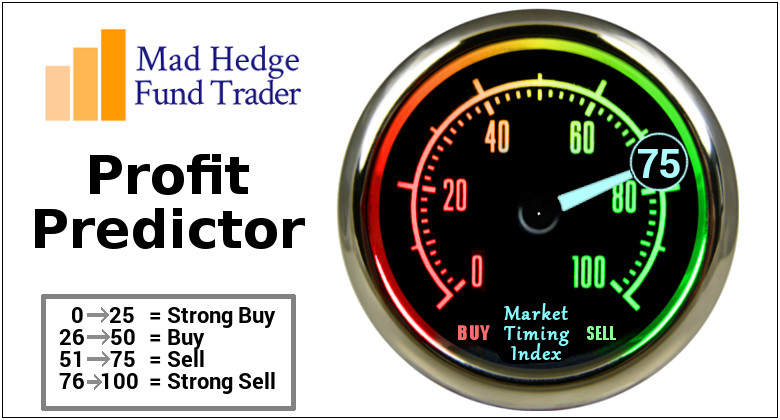
If your stomach was on edge before, then you must feel quite queasy now.
That’s only if you didn’t get rid of your chip stocks when I told you to.
The chip sector has been rife with issues for quite some time now, and I’ve been firing off bearish chip stories the past few months.
Intel (INTC) was one of the last chip companies I told you to avoid like the plague, please click here to review that story.
The contagion has spread wider.
Micron (MU), the Boise, Idaho-based chip giant, delivered poor guidance from its latest earnings report, adding more carnage to this trouble sector.
It’s been rough sailing for many American-based chip companies lately that are not named Advanced Micro Devices (AMD) and Nvidia (NVDA).
The protracted ongoing trade war between America and China that sees no end in sight is the fundamental reason to stay away from these chip companies that are the meat and potatoes inside of all electronic devices.
Cofounder of Alibaba (BABA) Jack Ma, who recently stepped down from his position as chairman, told news outlets that this trade war could last “20 years” and is “going to be a mess.”
Micron is affected by this trade war more than any other American company, with half of its annual revenue derived from the Middle Kingdom.
Out of the $20.32 billion in annual revenue last year, more than $10 billion was from China alone.
Micron is a leader in selling DRAM chips, which are placed in most portable electronic devices such as smartphones, video game consoles, and laptop computers.
The commentary coming out from chip executives has been overly negative and spells doom and gloom - supporting my view to be cautious on chips through the end of the year.
At the Citi 2018 Global Technology Conference in New York, KLA-Tencor (KLAC) chief financial officer Bren Higgins characterized the winter season DRAM market as “little less than what we thought,” describing margins as “modestly weaker.”
Lam Research (LRCX), once one of my favorite chip plays, offered bearish rhetoric about the state of chip investments, saying on its earnings call that is expected “lower spending on new equipment by some of its memory customers.”
It doesn’t take a rocket scientist to know that “memory customer” is Intel, which is in the throes of a CPU chip shortage rocking the overall personal computer market.
Personal computers face a steep 7% drop in sales volume for the rest of the year, and the knock-on effect is rippling throughout the industry.
The lower volume of produced computers means less memory needed, adding up to less sales for Micron.
This rationale forced Micron to guide down its revenue growth from 22% to 16% for the last quarter of 2018.
Intel’s monumental lapse has offered a golden opportunity for competitor Advanced Micro Devices (AMD) to steal market share from Intel in broad daylight.
This was the exact thesis that provoked me to urge readers to pile into AMD shares like a Tokyo rush-hour subway car.
Shares have gone ballistic to say the least.
(AMD) is poised to seize and reposition itself in the global CPU market with a 70/30 market share, up from the paltry 90/10 market share before Intel’s debacle.
To make matters worse for Intel, widespread reports indicate its shortage problems are “worsening.”
Such is a dog-eat-dog world out there when a company can triple market share in a blink of an eye.
The rotation is real with HP (HPQ) planning to integrate AMD chips into 30% of its consumer PCs, and Dell already mentioning it will use AMD chips to make up for the shortages.
The resilience in chip demand remains the silver lining for this industry as price weakness and production shortages will be finite.
Server demand remains particularly robust.
Google, Amazon, Facebook, and Microsoft coughed up $34.7 billion on data centers to serve cloud-based operation in the first half of the year in 2018, a sharp increase of 59% YOY.
Investors have been paranoid of the boom-bust nature of the chip industry for decades.
Each cycle sees spending and chip pricing rocket, only for inventories to build up and demand to evaporate in an instant.
The beginning of the end always starts with lower guidance, followed up with missed earnings the next quarter.
This playbook has repeated itself over and over.
Micron guided first quarter revenue of 2019 in a range between $7.9 billion to $8.3 billion, lower than the consensus of $8.45 billion.
And, if all of this horrid chip news wasn’t reason to rip your hair out - here is the bombshell.
To wean itself off the reliance of American chips, Alibaba has created a subsidiary to produce its own chips called Pingtouge Semiconductor Company.
Pingtouge refers to honey badger in the Chinese language, symbolic for its tenacity in the face of adversity – perhaps a thinly-veiled dig at the American political system.
Former Chairman Ma pocketed this chip company Hangzhou C-SKY Microsystems last year. It will will be given ample leeway and resources to team up with Alibaba to roll out its first commercial chip next year.
Alibaba has rapidly grown into the third-largest cloud player in the world, and require an abundant source of chips moving forward.
Chips tricked out with artificial intelligence will be adopted by not only its data centers, but integrated with its autonomous driving technology and IoT products, which are markets that Alibaba is proud to be part.
You can find Alibaba’s cloud products present in more than 20 countries. And the company that Jack Ma built forecasts to generate more than 50% of its revenue from overseas markets soon.
It could be Jack Ma laughing all the way to the bank.
Ultimately, Micron produced fair results last quarter, but like Facebook found out, if investors believe the company is about to fall off a cliff, it offers little resistance to the share price on a short-term basis.
Could the cyclicality demons start to awake to drag this company down?
Partially, yes, but there are still many positives to take away from this leading chip company.
China will need years to remedy its addiction of American chips.
It will not be able to produce the scope of quality or quantity to just stop buying from American companies for the foreseeable future.
The authorized $10 billion share buyback gave Micron shares a nice lift earlier this year, but the industry dynamics are now deteriorating rapidly.
Chip sentiment is at its lowest ebb for some time, and I reaffirm my call to avoid this sector completely unless it’s the two cornerstone chip companies showing systematic resiliency - (AMD) or Nvidia (NVDA).
The administration initially slapped on a tariff rate of 10% on $200 billion worth of goods with intentions to scale it up.
If nothing is solved, the increase to 25% will cause another 5% to 10% drop in Micron and Intel.
Then if the administration plans to go after the rest of the $250 billion of Chinese imports, expect another dive in chip shares.
Either way, each jawboning tweet as we head deeper into this trade conflict will damage Micron’s shares.
This sector is getting squeezed from many sides now, and if you don’t go outright short chip companies, then stay away until the storm clouds pass over and you can reassess the situation.
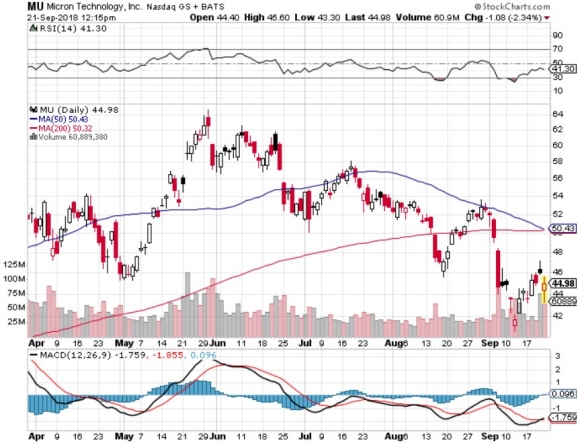
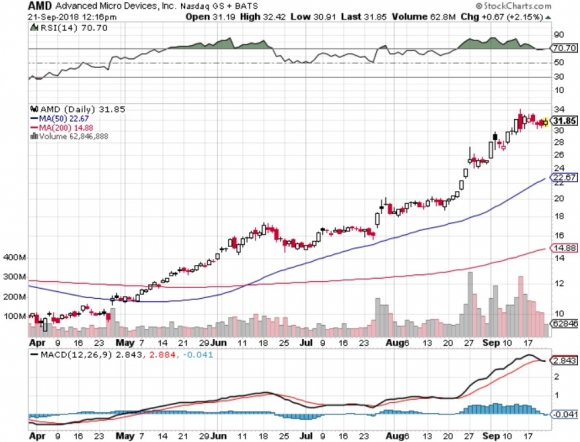
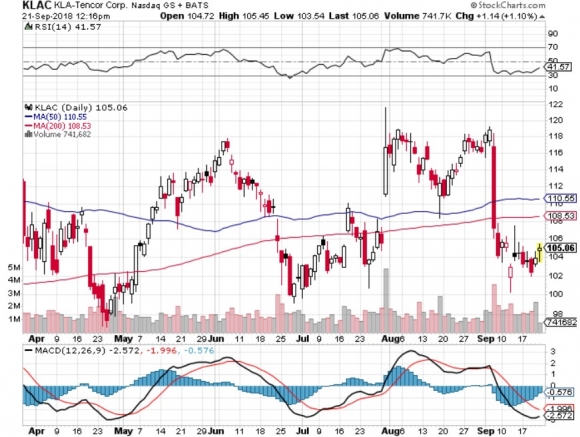
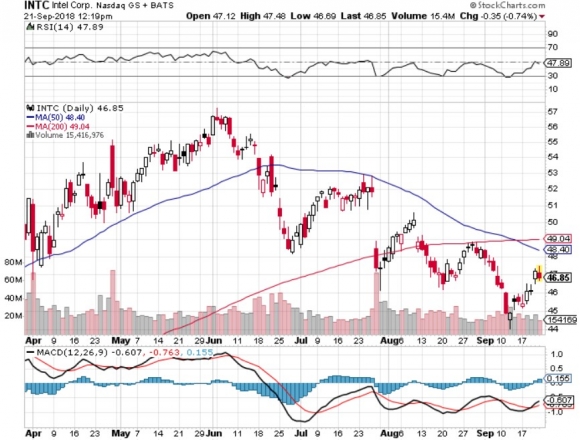
Mad Hedge Technology Letter
May 8, 2018
Fiat Lux
Featured Trade:
(BUFFETT GOES ALL IN WITH APPLE),
(SNAP), (WDC), (GOOGL), (AMZN),
(CRM), (RHT), (HPQ), (FB), (AAPL)
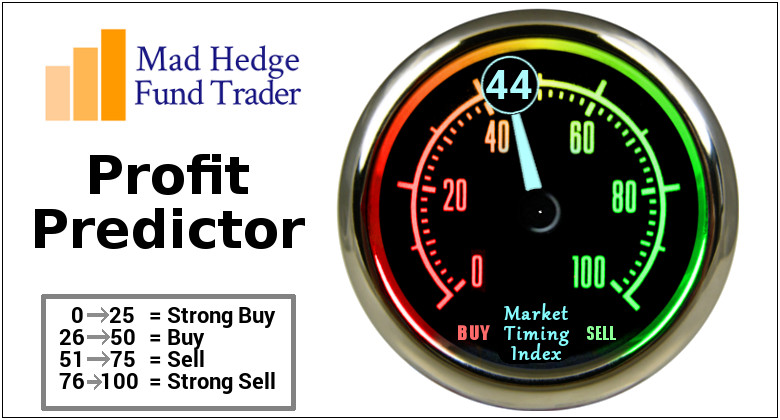
Not every stock comes with Warren Buffett's confession that he would like to own 100% of it. But, of course that stock would have to be a tech stock.
As it stands, the Oracle of Omaha owns 5% of Apple (AAPL), and his confession is still a bold statement for someone who seldom forays outside his comfort zone.
Buffett also continues to concede that he "missed" Google (GOOGL) and Amazon (AMZN).
What a revelation!
The outflow of superlatives invading the airwaves is indicative of the strength technology has assumed in the bull market.
The tech sector has been coping with obstacles such as higher interest rates, trade wars, data regulation, IP chaos, and the globalization backlash.
However, the tech companies have come through unscathed and hungry for more.
Their power is not contained to one industry, and techs' capabilities have been spilling over into other sectors digitizing legacy industries.
Every CEO is cognizant that enhancing a product means blending the right amount of tech to suit its needs.
It is not halcyon times in all of tech land either.
There have been some companies that have faltered or were naturally cannibalized by other tech companies that disrupt business.
Times are ruthless and this is just the beginning.
There will be winners and losers as with most other secular paradigm shifts.
Particularly, there are two types of losers that investors need to avoid like the plague.
The first is the prototypical tech company hawking legacy products such as Western Digital Corp. (WDC) that I have been banging on the table telling investors not to buy the stock.
The lion's share of revenue is still in the antiquated hard drive business that has a one-way ticket to obsolescence.
Yes, they are turning around product mixes to factor in its pivot to solid state drives (SSD), but they are late to the game and deservedly punished for it.
Compare WDC to companies that have completed the transition from legacy reliance to the cloud, and it is simple to understand that companies such as Microsoft, which struggled for years to turn around with CEO Satya Nadella, finally can claim victory.
The problem with WDC is the stock's price action performs miserably because the company is tagged as an ongoing turnaround story.
On the other hand, headliner cloud plays experience breathtaking gaps up due to the strength of the cloud such as Amazon (AMZN), Red Hat (RHT), and Salesforce (CRM), just to name a few.
To pour fuel on the fire, speculative reports citing NAND chip price "softening" beat down the stock into submission.
Effectively, legacy companies become sell the rallies type of stocks.
Transforming a legacy company into a high-octane cloud company is perilous to say the least. Jeff Bezos recently gloated that Amazon Web Service's (AWS) seven-year head start is all investors need to know about the cloud. There is some merit to his statement.
Examples are rife with bad executive decisions by legacy companies such as HP Inc. (HPQ), another legacy tech company that makes computers and hardware. It ventured out to buy Palm for $1.2 billion plus debt after a bidding war with legacy competitor Dell in 2010.
In 1996, the Palm PDA (Personal Digital Assistant) was the first smart phone on the market that predated BlackBerry's smart phone with the full keyboard made by RIM (Research in Motion).
The demise of Palm emerged from a hodgepodge of mismanagement, failed spin-offs, misplaced mergers, and resource wastefulness even with the preeminent technology of its time.
(HPQ)'s stab at the smartphone market resulted in purchasing Palm. However, after heavy selling pressure in its shares, HP shut down this division and sold off the remaining technology to Chinese electronics company TCL Corporation.
The sad truth is many transformations fail at step one, and there is no guarantee a newly absorbed business will perform as expected.
RIM, now changed to BlackBerry (BB), soon found out how it felt to be Palm when Steve Jobs dropped the first iPhone on the market, and the world has never been the same.
(BB) gradually morphed into an autonomous vehicle technology company after the writing was on the wall.
The other types of losers are companies with inferior business models such as Snapchat (SNAP), which I have written about extensively from the bearish side.
In an age where disruptors are being disrupted by other disruptors, CEOs must live in fear that their business will get undercut and hijacked at any time.
Instagram, a subsidiary of Facebook (FB), has permanently borrowed numerous features from Snapchat. Its Instagram "stories" feature is now used by more than 300 million daily users.
Snapchat is serving as Instagram's guinea pig while CEO Evan Spiegel finds an alternative way to survive against Facebook's unlimited resources.
Both are in the game of selling ads and nobody does it better than Facebook and Alphabet or has the degree of scale.
The recent redesign was met with a chorus of universal boos. The 60 minutes I spent testing the new design reconfirmed my fears that the new design was an unmitigated washout.
In short, Snap's redesign seemed like a different app and became incredibly difficult to use.
Compounding the deteriorating situation, Snapchat laid off 120 engineers due to sub-par performance and withheld last year's performance bonuses even though co-founder Evan Spiegel received $637 million in 2017.
The latest earnings report was a catastrophe.
Daily active user (DAU) growth, the most sought out metric for Snapchat, failed to deliver the goods. The street expected 194.2 million DAU and Snap reported 191 million. A miss of 3.2 million users and a deceleration of growth QOQ.
Remember that Snapchat is substantially smaller than Instagram and should have no problems surpassing expectations on a smaller scale, thus investors voted with their feet and bailed on the stock after the catatonic performance last quarter.
Instagram is six times larger with more than 800 million users as of the end of 2017.
Top line fell short of expectations and average revenue per user (ARPU) dropped to $1.21, far less than the expected $1.27.
The less than stellar redesign faced a rebellion from long-term Snapchat disciples. More than 1.2 million Snap diehards signed a petition hoping to revert back to the old interface, and its updated ratings in Apple's app store has fallen to 1.6 stars out of 5.
Then the perpetual question of why would advertisers want to pay for Snapchat digital ads when they earn more by buying Instagram ads?
This remains unsolved and appears unsolvable.
Snapchat is befuddled by the pecking order and the company is on a train to nowhere.
To hammer the nail in the coffin, Snapchat announced to investors that it expects revenue to "decelerate substantially" next quarter.
In an era where technology companies will lead the economy and stock market, and has an outsized influence in politics and culture, not all tech companies are one-foot tap-ins.
Investors need to separate the wheat from the chaff or risk losing their shirt.
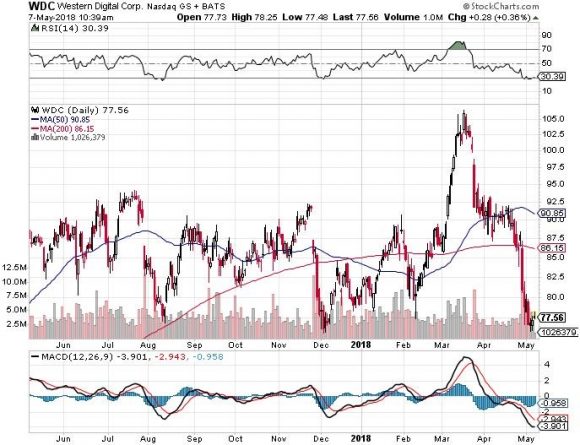
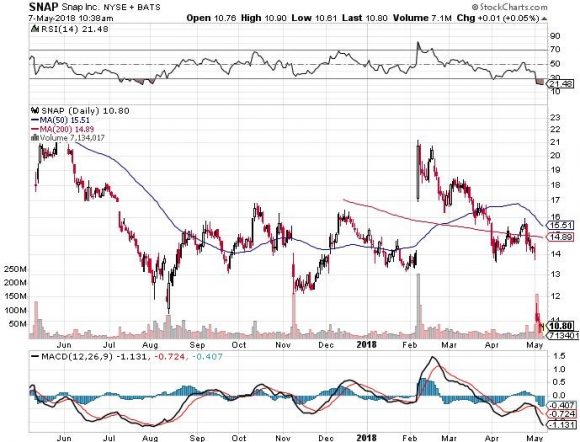

_________________________________________________________________________________________________
Quote of the Day
"We have to stop optimizing for programmers and start optimizing for users." - said American software developer Jeff Atwood

Legal Disclaimer
There is a very high degree of risk involved in trading. Past results are not indicative of future returns. MadHedgeFundTrader.com and all individuals affiliated with this site assume no responsibilities for your trading and investment results. The indicators, strategies, columns, articles and all other features are for educational purposes only and should not be construed as investment advice. Information for futures trading observations are obtained from sources believed to be reliable, but we do not warrant its completeness or accuracy, or warrant any results from the use of the information. Your use of the trading observations is entirely at your own risk and it is your sole responsibility to evaluate the accuracy, completeness and usefulness of the information. You must assess the risk of any trade with your broker and make your own independent decisions regarding any securities mentioned herein. Affiliates of MadHedgeFundTrader.com may have a position or effect transactions in the securities described herein (or options thereon) and/or otherwise employ trading strategies that may be consistent or inconsistent with the provided strategies.
This site uses cookies. By continuing to browse the site, you are agreeing to our use of cookies.
OKLearn moreWe may request cookies to be set on your device. We use cookies to let us know when you visit our websites, how you interact with us, to enrich your user experience, and to customize your relationship with our website.
Click on the different category headings to find out more. You can also change some of your preferences. Note that blocking some types of cookies may impact your experience on our websites and the services we are able to offer.
These cookies are strictly necessary to provide you with services available through our website and to use some of its features.
Because these cookies are strictly necessary to deliver the website, refuseing them will have impact how our site functions. You always can block or delete cookies by changing your browser settings and force blocking all cookies on this website. But this will always prompt you to accept/refuse cookies when revisiting our site.
We fully respect if you want to refuse cookies but to avoid asking you again and again kindly allow us to store a cookie for that. You are free to opt out any time or opt in for other cookies to get a better experience. If you refuse cookies we will remove all set cookies in our domain.
We provide you with a list of stored cookies on your computer in our domain so you can check what we stored. Due to security reasons we are not able to show or modify cookies from other domains. You can check these in your browser security settings.
These cookies collect information that is used either in aggregate form to help us understand how our website is being used or how effective our marketing campaigns are, or to help us customize our website and application for you in order to enhance your experience.
If you do not want that we track your visist to our site you can disable tracking in your browser here:
We also use different external services like Google Webfonts, Google Maps, and external Video providers. Since these providers may collect personal data like your IP address we allow you to block them here. Please be aware that this might heavily reduce the functionality and appearance of our site. Changes will take effect once you reload the page.
Google Webfont Settings:
Google Map Settings:
Vimeo and Youtube video embeds:
